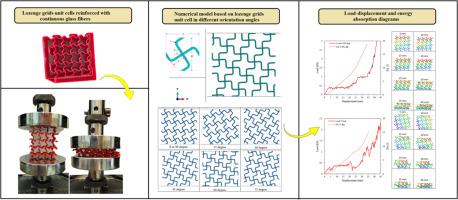Experimental and numerical investigation of energy absorption in honeycomb structures based on lozenge grid unit cells under various loading angles
IF 5.3
Q2 MATERIALS SCIENCE, COMPOSITES
引用次数: 0
Abstract
The present study aims to numerically and experimentally analyze the energy absorption characteristics of honeycomb structures using Lozenge grid unit cells made from continuous glass fibers reinforced polylactic acid (PLA). The design and load-bearing capability of the Lozenge grid was also examined under different orientations angles. The composite grids were also subjected to heat treatment after the tests, at 70 °C, in order to measure its effect on the energy absorption capacity. The Lozenge grid specimens were additively manufactured using fused filament fabrication. The mechanical properties and failure models were described using the VUSDFLD subroutine in order to simulate the Lozenge structure under quasi-static compressive load. The results revealed a good correlation between the numerical and the experimental values. Moreover, Lozenge grid unit cells based structures at 0 or 90° was found with the highest energy absorption capacity. Meanwhile, the least energy absorption was seen at 45°. Overall, the structures had much higher energy absorption capacity at angles closer to 0 and 90°. Outcomes from this work is aimed toward understanding the damage tolerance of Lozenge lattices, and hence the reliability of such new emerging lightweight structures.

基于菱形网格的蜂窝结构在不同载荷角度下能量吸收的实验与数值研究
采用连续玻璃纤维增强聚乳酸(PLA)制成的菱形网格单元格,对蜂窝结构的吸能特性进行了数值和实验分析。同时,对菱形网格在不同朝向角度下的设计和承载能力进行了研究。试验结束后,还对复合栅格进行了70℃的热处理,以测量其对能量吸收能力的影响。菱形网格试样采用熔丝增材制造。利用VUSDFLD子程序对菱形结构在准静态压缩载荷作用下的力学性能和破坏模型进行了描述。结果表明,数值与实验值具有良好的相关性。此外,0°和90°的菱形网格结构具有最高的能量吸收能力。同时,45°时吸能最小。总的来说,在接近0°和90°角时,结构具有更高的能量吸收能力。这项工作的结果旨在了解菱形晶格的损伤容限,从而提高这种新型轻量化结构的可靠性。
本文章由计算机程序翻译,如有差异,请以英文原文为准。
求助全文
约1分钟内获得全文
求助全文
来源期刊

Composites Part C Open Access
Engineering-Mechanical Engineering
CiteScore
8.60
自引率
2.40%
发文量
96
审稿时长
55 days
 求助内容:
求助内容: 应助结果提醒方式:
应助结果提醒方式:


